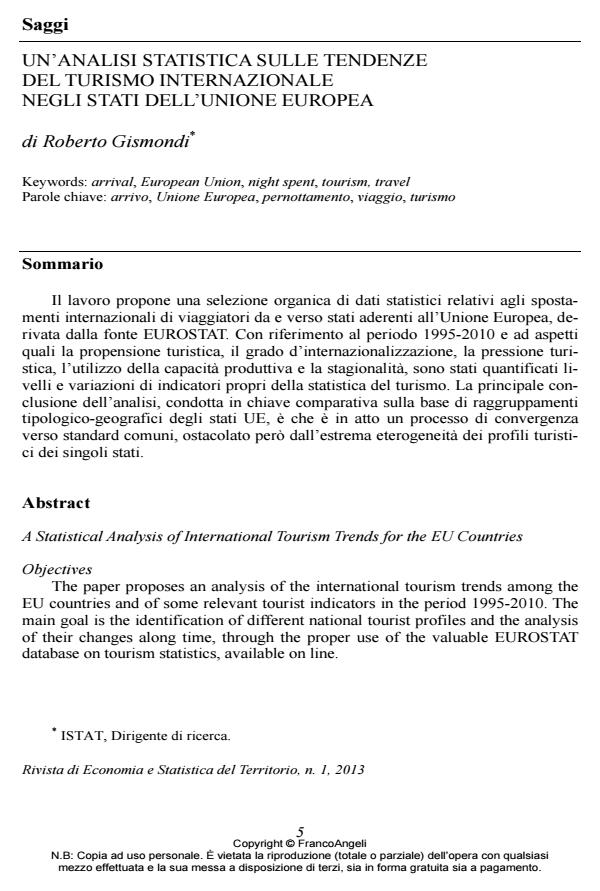A Statistical Analysis of International Tourism Trends for the EU Countries
Journal title RIVISTA DI ECONOMIA E STATISTICA DEL TERRITORIO
Author/s Roberto Gismondi
Publishing Year 2013 Issue 2013/1
Language Italian Pages 29 P. 5-33 File size 676 KB
DOI 10.3280/REST2013-001001
DOI is like a bar code for intellectual property: to have more infomation
click here
Below, you can see the article first page
If you want to buy this article in PDF format, you can do it, following the instructions to buy download credits

FrancoAngeli is member of Publishers International Linking Association, Inc (PILA), a not-for-profit association which run the CrossRef service enabling links to and from online scholarly content.
The paper proposes an analysis of the international tourism trends among the EU countries and of some relevant tourist indicators in the period 1995-2010. The main goal is the identification of different national tourist profiles and the analysis of their changes along time, through the proper use of the valuable EUROSTAT database on tourism statistics, available on line. Methods and Results Data derive from a statistical database managed by EUROSTAT and fed through regular updates from the single EU countries. The database has been deeply enriched and harmonized just in the last years, as a direct consequence of the new EU Regulation on Tourism Statistics. Data have been selected in order to supply information on five main tourist features: domestic tourism, foreign tourism, tourist pressure, productivity and seasonality. They have been normalized through imputation of missing micro-data and then properly used for the calculation of specific statistical indicators, which prevent from size effects and guarantee international comparability. The analyses are presented at the level of 4 groups of countries; a final ranking of the 27 EU states according to nine main competitiveness indicators has been proposed as well. Conclusions Some of the main outcomes are: a) trends of nights spent and travels in the EU are mainly positive, but are slowing down in the recent years; b) broadly speaking, foreign tourism is increasing quite faster than domestic tourism; c) productivity indicators as the number of nights spent by bed place or by person employed are decreasing almost everywhere in the EU; d) Italy is still hampered by structural problems as high seasonality and low share of foreign tourists. However, its rank in the EU competitiveness scale is near the average.
Keywords: Arrival, European Union, night spent, tourism, travel
- Costa P., Manente M. (2000), Manuale di economia del turismo, Milano: Touring Club Italiano
- Chen J. (2000), Applications of Multivariate Analysis in International Tourism Research: The Marketing Strategy Perspective of NTOs, Journal of Economic and Social Research, 3 (1), pp. 77-98
- Commissione delle Comunità Europee (2006), Rinnovare la politica comunitaria per il turismo: una partnership più forte per il turismo europeo, http://eurlex. europa.eu/smartapi/cgi
- Eilat Y., Einav L. (2004), Determinants of International Tourism: A Threedimensional Panel Data Analysis, Applied Economics, 36, 12, pp. 1315-1327.
- Enright M.J., Newton G. (2004), Tourism Destination Competitiveness: A Quantitative Approach, Tourism Management, 25, 6, pp. 777-788.
- European ParlIAMENT (2011), Regulation (EU) N.692/2011 of the European Parliament and of the Council of 6 July 2011 concerning European statistics on tourism and repealing Council Directive 95/57/EC, on line: http://eurex. europa.eu/LexUriServ/LexUriServ.do?uri=OJ:L:2011:192:0017:0032:EN:PDF.
- Farsari Y., Prastacos P. (1999), Sustainable Tourism Indicators for Mediterranean Destinations: Definitions According to the ST Principles, Proceedings ERSA’s XII Summer Institute: “Tourism Sustainability and Territorial Organization”, Portugal
- Gismondi R., Russo M.A. (2005), Definizione e calcolo di un indice territoriale di turisticità: un approccio statistico multivariato, Statistica, LXIV, 3, pp. 545- 571.
- Gismondi R., Russo M.A. (2006), Foreign Tourist Arrivals to Italy: A Statistical Model, Rivista italiana di economia, demografia e statistica, LX, 3-4, pp. 301- 309
- Giudici P., Avrini P. (2002), Modelli statistici per la costruzione di indicatori della qualità della vita: aspetti metodologici, Rivista di statistica ufficiale, 1, pp. 61- 80.
- Gooroochrun N., Sugiyarto G. (2005), Competitiveness Indicators in the Travel and Tourism Industry, Tourism Economics, 11 (1), pp. 25-43.
- Kozak M., Rimmington M. (1999), Measuring Tourist Destination Competitiveness: Conceptual Considerations and Empirical Findings, International Journal of Hospitality Management, XVIII, 3, pp. 273-283
- Seddighi H.R., Theocharous A.L. (2002), A Model of Tourism Destination Choice: A Theoretical and Empirical Analysis, Tourism Management, XXIII, 5, pp. 475-487.
- Toivonen T. (2004), Changes in the Propensity to Take Holiday Trips Abroad in EU Countries Between 1985 and 1997, Tourism Economics, 10 (4), pp. 403- 417.
- Le imprese in crescita e la ricomposizione dell'occupazione nei settori del made in italy del veneto Sebastiano Basso, Gianluca Emireni, Maurizio Gambuzza, in ECONOMIA E SOCIETÀ REGIONALE 1/2015 pp.85
DOI: 10.3280/ES2015-001007
Roberto Gismondi, Un’analisi statistica sulle tendenze del turismo internazionale negli stati dell’Unione Europea in "RIVISTA DI ECONOMIA E STATISTICA DEL TERRITORIO" 1/2013, pp 5-33, DOI: 10.3280/REST2013-001001